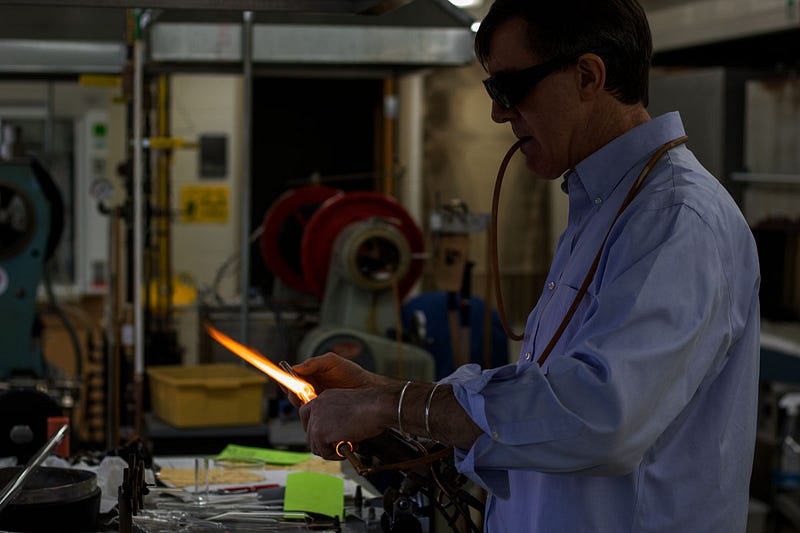Tracy Drier of UW-Madison is working hard to create an environment where people can learn new skills while having fun combining art and science.

College is a place to experience new things, and UW-Madison is a hub for such experiences. Tracy Drier, a professional glass-blower at UW-Madison, is determined to give students that “new experience” that not only allows students to learn a valuable skill, but to also have fun.
Drier is an expert in glassblowing. When people think of glassblowing, they imagine a hobby where one creates fancy and colorful bowls or paperweights with little to no real-world application. However, Drier turned glassblowing into a career where he fixes glassware and creates new pieces that can be used for scientific experiments. Typically, researchers within UW-Madison approach Drier with important pieces of lab glassware in need of repair. Having an in-house repairman for this purpose saves the university a lot of time and money.
The process for glassblowing starts with a researcher’s idea which they bring to Drier, who comes up with a design. From this design, the two discuss the project’s feasibility. Moving forward with the piece, Drier then takes individual glass rods with certain diameters and attaches pieces by placing the glass in a flame to transform it. While Drier works on the glass, he also blows air into a rubber tube to open the glass. Blowing into the glass in this way makes it malleable so that Drier can open up the end and smooth out the rough parts. The entire process requires precision and years of skill.
Drier was instrumental in research for the Photoelectrochemical Water-Splitting Cell that was researched by Kongki Lee, a researcher at UW-Madison. Lee’s research entailed splitting water molecules into hydrogen gas and oxygen gas. Drier made the device while Lee instructed him on the specifics. Such an intricate process can take hours. “Kongki gave me a drawing of what he wanted, it was only a scale drawing. It still did not tell me much, and in the end, we went back and forth for a total of six hours filling in the blanks,” Drier stated. This time does not include the actual building time. Drier says, “It’s very challenging having to make new fixtures that allow scientists to do what they want to do.” Like a fairy godmother, Drier brings UW’s research drawings to life.
Drier started glassblowing due to his love for artistry and hands-on fabrication. We often forget the necessity of attention to detail, which thanks to Drier’s motivation and dedication, is not a problem. Drier says, “Having to work with glass means working everyday with a new challenge and new design … it never gets tiring to me.”
The skill of repairing glassware and being able to mold it to certain specifications is rare. Scientists need new devices that have not been created and Drier’s job is to bring experiments to life. Not only does Drier help researchers, but he also teaches a glass-blowing class for Chemistry graduate students. Drier says, “This job lets me interact with scientists…to be able to talk about the science behind my work is really exciting to me.” He finds this job particularly rewarding since he can pursue his passion and learn new scientific discoveries.
Glassblowing is an underappreciated skill, which is why Drier is making many initiatives to jumpstart interests in the field. Drier says, “There is a need for glassblowers,” because of their ability to create new fixtures. Evidently, science and art do not have to be mutually exclusive and Drier’s glassblowing is a shining example.
